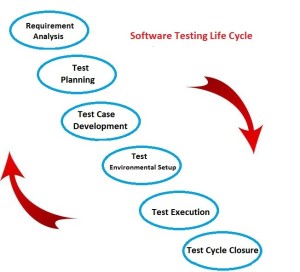STLC (Software Test Life Cycle)
Life-cycle in simple term refers to the sequence of changes from one form to other form. These changes can happen to any tangible or intangible things. Every entity has a life-cycle from its inception to retire / demise.In a similar fashion, Software is also an entity. Just like developing software involves a sequences of steps, testing also has steps which should be executed in a definite sequence.This phenomenon of executing the testing activities in a systematic and planned way is called testing life cycle.
The process of testing a software in a well planned and systematic way is known as software testing life cycle(STLC).Different organizations have different phases in STLC however generic Software Test Life Cycle (STLC) for waterfall development model consists of the following phases.
1. Requirements Analysis
2. Test Planning
3. Test Scenarios and Test Cases Development
4. Test Environment Setup
5. Test Execution and Bug Reporting
6.Test Cycle Closure

1.Requirements Analysis
In this phase testers analyze the customer requirements and work with developers during the design phase to see which requirements are testable and how they are going to test those requirements.It is very important to start testing activities from the requirements phase itself because the cost of fixing defect is very less if it is found in requirements phase rather than in future phases.
2.Test Planning
In this phase all the planning about testing is done like what needs to be tested, how the testing will be done, test strategy to be followed, what will be the test environment, what test methodologies will be followed, hardware and software availability, resources, risks etc. A high level test plan document is created which includes all the planning inputs mentioned above and circulated to the stakeholders.
3. Test Scenarios and Test Cases Development
The test scenarios and test cases development activity is started once the test planning activity is finished.This is the phase of STLC where testing team write down the detailed test scenarios and test cases. Along with these, testing team also prepare the test data if any required for testing. Once the test cases are ready then these test cases are reviewed by peer members or QA lead. Also the Requirement Trace-ability Matrix (RTM) is prepared. The Requirement Trace-ability Matrix is an industry-accepted format for tracking requirements where each test case is mapped with the requirement. Using this RTM we can track backward & forward trace-ability.
4. Test Environment Setup
Setting up the test environment is vital part of the STLC. Basically test environment decides on which conditions software is tested. This is independent activity and can be started parallel with Test Case Development. In process of setting up testing environment test team is not involved in it. Based on company to company may be developer or customer creates the testing environment. Mean while testing team should prepare the smoke test cases to check the readiness of the test environment setup.
5. Test Execution and Bug Reporting
Once the unit testing is done by the developers and test team gets the test build, The test cases are executed and defects are reported in bug tracking tool, after the test execution is complete and all the defects are reported. Test execution reports are created and circulated to project stakeholders.
After developers fix the bugs raised by testers they give another build with fixes to testers, testers do re-testing and regression testing to ensure that the defect has been fixed and not affected any other areas of software.Testing is an iterative process i.e. If defect is found and fixed, testing needs to be done after every defect fix.After tester assures that defects have been fixed and no more critical defects remain in software the build is given for final testing.
6.Test Cycle Closure
Call out the testing team member meeting & evaluate cycle completion criteria based on Test coverage, Quality, Cost, Time, Critical Business Objectives, and Software. Discuss what all went good, which area needs to be improve & taking the lessons from current STLC as input to upcoming test cycles, which will help to improve bottleneck in the STLC process. Test case & bug report will analyze to find out the defect distribution by type and severity. Once complete the test cycle then test closure report & Test metrics will be prepared. Test result analysis to find out the defect distribution by type and severity.

Best Open Source Business Intelligence Software Helical Insight is Here
